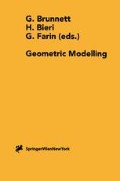Abstract
In recent published papers we presented the Extreme Vertices Model (EVM), a concise and complete model for representing orthogonal polyhedra and pseudopolyhedra (OPP). This model exploits the simplicity of its domain by allowing robust and simple algorithms for set-membership classification and Boolean operations that do not need to perform floating-point operations.
Several applications of this model have also been published, including the suitability of OPP as geometric bounds in Constructive Solid Geometry (CSG).
In this paper, we present an algorithm which converts from this model into a B-Rep model. We also develop the application of the Alternating Sum of Volumes decomposition to this particular type of polyhedra by taking advantage of the simplicity of the EVM. Finally we outline our future work, which deals with the suitability of the EVM in the field of digital images processing.
Access this chapter
Tax calculation will be finalised at checkout
Purchases are for personal use only
Preview
Unable to display preview. Download preview PDF.
References
Aguilera, A.: Orthogonal polyhedra: study and application. PhD thesis, LSI-Universitat Politècnica de Catalunya, (1998).
Aguilera, A., Ayala, D.: Orthogonal polyhedra as geometric bounds in constructive solid geometry. In: ACM SM’97 (Hoffmann, C., Bronsvort, W., eds.), pp. 56–67. Atlanta, 1997.
Aguilera, A., Ayala, D.: Domain extension for the extreme vertices model (EVM) and set-membership classification. In: CSG’98. Ammerdown (UK), pp. 33–47. Information Geometers Ltd., 1998.
Aguilera, A., Ayala, D.: Solving point and plane vs. orthogonal polyhedra using the extreme vertices model (EVM). In: WSCG’98. The Sixth Int. Conf. in Central Europe on Computer Graphics and Visualization’98 (Skala, V., ed.), pp. 11–18. University of West Bohemia. Plzen (Czech Republic), 1998.
Andújar, C., Ayala, D., Brunet, P.: Validity-preserving simplification of very complex polyhedral solids. In: Virtual Environments’99 (Gervautz, M., Hildebrand, A., Schmalstieg, D., eds.), pp. 110. Wien New York: Springer, 1999.
Andújar, C., Ayala, D., Brunet, P., Joan-Arinyo, R., Solé, J.: Automatic generation of multiresolution boundary representations. Comput. Graphics Forum 15, C87–C96 (1996).
Ayala, D., Andújar, C., Brunet, P.: Automatic simplification of orthogonal polyhedra. In: Modeling, virtual worlds, distributed graphics: proceedings of the international MVD’96 workshop (Fellner, D., ed.), pp. 137–147. Infix, 1995.
Bieri, H.: Computing the Euler characteristic and related additive functionals of digital objects from their bintree representation. Comput. Vision Graphics Image Proc. 40, 115–126 (1987).
Bieri, H.: Hyperimages - an alternative to the conventional digital images. In: EUROGRAPHICS’90 (Vandoni, C. E., Duce, D. A., eds.), pp. 341–352. Amsterdam: North-Holland, 1990.
Boumez, O., Maler, O., Pouch, A.: Orthogonal polyhedra: representation and computation. In: Hybrid systems: computation and control, pp. 46–60. Berlin Heidelberg New York Tokyo: Springer, 1999 (Lecture Notes in Computer Science 1569)
Dang, T., Maler, O.: Reachability analysis via face lifting. In: Hybrid systems: computation and control (Henzinger, T. A., Sastry, S., eds.), pp. 96–109. Berlin Heidelberg New York Tokyo: Springer, 1998 (Lecture Notes in Computer Science 1386).
Hoffmann, C. M.: Geometric and solid modeling. New York: Morgan Kauffmann, 1989.
Juan-Arinyo, R.: On boundary to CSG and extended octrees to CSG conversions. In: Theory and practice of geometric modeling (Strasser, W., ed.), pp. 349–367. Berlin Heidelberg New York Tokyo: Springer, 1989.
Juan-Arinyo, R.: Domain extension of isothetic polyhedra with minimal CSG representation. Comput. Graphics Forum 5, 281–293 (1995).
Kim, Y. S.: Recognition of form features using convex decomposition. Comput. Aided Des. 24, 461–476 (1992).
Kim, Y. S., Wilde, D.: A convergent convex decomposition of polyhedral objects. In: SIAM Conf. Geometric Design, (1989).
Kyprianou, L. K.: Shape classification in computer-aided design. PhD thesis, University of Cambridge, 1980.
Latecki, L.: 3D well-composed pictures. Graph. Models Image Proc. 59, 164–172 (1997).
Latecki, L., Eckhardt, U., Rosenfeld, A.: Well-composed sets. Comput. Vision Image Understand. 61, 70–83 (1995).
Lorensen, W., Cline, H.: Marching cubes: A high resolution 3D surfaces construction algorithm. Comput. Graphics 21, 163–169 (1987).
Pratt, M. J.: Towards optimality in automated feature recognition. Computing [Suppl] 10, 253–274 (1995).
Preparata, F. P., Shamos, M. I.: Computational geometry: an introduction. Berlin Heidelberg New York: Springer, 1985.
Requicha, A.: Representations for rigid solids: Theory, methods, and systems. Comput. Surv. ACM 12, 437–464 (1980).
Samet, H.: The design and analysis of spatial data structures. Reading: Addison-Wesley, 1989.
Srihari, S. N.: Representation of three-dimensional digital images. ACM Comput. Surv. 13, 399–424 (1981).
Tang, K., Woo, T.: Algorithmic aspects of alternating sum of volumes. Part 1: Data structure and difference operation. CAD 23, 357–366 (1991).
Udupa, J. K.. Odhner, D.: Shell rendering. IEEE Comput. Graphics Appl. 13, 58–67 (1993).
Waco, D. L., Kim, Y. S.: Geometric reasoning for machining features using convex decomposition. CAD 26, 477–489 (1994).
Woo, T.: Feature extraction by volume decomposition. In: CAD/CAM Technology in Mechanical Engineering, (1982).
Author information
Authors and Affiliations
Editor information
Editors and Affiliations
Rights and permissions
Copyright information
© 2001 Springer-Verlag Wien
About this paper
Cite this paper
Aguilera, A., Ayala, D. (2001). Converting Orthogonal Polyhedra from Extreme Vertices Model to B-Rep and to Alternating Sum of Volumes. In: Brunnett, G., Bieri, H., Farin, G. (eds) Geometric Modelling. Computing, vol 14. Springer, Vienna. https://doi.org/10.1007/978-3-7091-6270-5_1
Download citation
DOI: https://doi.org/10.1007/978-3-7091-6270-5_1
Publisher Name: Springer, Vienna
Print ISBN: 978-3-211-83603-3
Online ISBN: 978-3-7091-6270-5
eBook Packages: Springer Book Archive

